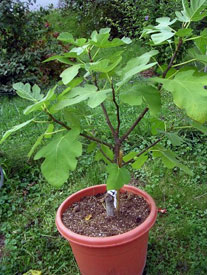Buying and planting
Plants are bought from garden centres in containers and are usually either single- or multistemmed. As figs can become large, vigorous plants they can be used to cover large walls, even the sides of houses.
However, most people should choose one that will eventually reach about 2m (61/2ft) high and 3-3.5m (10-11ft) wide — the equivalent of two fence panels. Plant it 20cm (8in) away from the wall, in spring. Spring is also the best time for potting up a fig plant. Start the plant off in a 25cm (10in) container, and as the plant grows pot it up each year, with it eventually ending up in a 45cm (18in) pot. Use a container with plenty of drainage holes and lots of broken crocks at the bottom. Standing the container on bricks helps excess water drain away. If you are wanting to plunge a containerized fig into open ground, fill a 30-40cm (12-16in) pot with John Innes No 3 soil mix and the young fig plant. Then position the pot well into the ground.
Plant care
In spring, apply a general-purpose granular feed. Then mulch around the base of the tree with well- rotted manure, to help to retain moisture and suppress weeds. Give figs plenty of water — probably each day during summer. Also during the growing season apply a tomato fertiliser every two weeks until the figs start to ripen. One of the advantages of figs is that you don't have to worry about pollination; the fruit are seedless and so develop without the need for fertilization. Except for the very warmest of sites, protect fig plants during the colder months. In autumn, move plants that have been grown in pots into an unheated greenhouse, and return them back outside in late spring. Pack a fan-trained plant with straw, bracken, or even bubble wrap and then cover with horticultural fleece . Remove such insulation gradually during late spring. Dig around the outside of a planting pit every couple of years with a sharp spade to ensure that no roots have escaped.
Repot figs every couple of years even when they have reached their established size. Remove them from their pot, gently prise out their roots from the root ball. Then replant into fresh John lnnes No 3 soil- based potting compost.
You can visit this flower guide for more information about this article.

It's been good to see your blog when I always look for such type of blogs. It’s great to discover the post here. Send Gifts To Delhi
ReplyDeleteI am really impressed by see your article It Is So Interesting post What a fabulous work Really it will help lot of people . I am very happy to read your article thanks for sharing with us.send flowers to allahabad
ReplyDeletenice one Delhi Online Floris
ReplyDeleteSend Flowers To Kolkata
ReplyDelete
ReplyDeleteOver an occasion period, individuals have associated several kinds of human feelings with different kinds of flowers based on their fragrance and color
am really impressed by see your article It Is So Interesting post What a fabulous work Really it will help lot of people . I am very happy to read your article thanks for sharing
ReplyDeleteI Am Very Happy To See Your Blog And It Is Very Useful For Me And I Gathererd Many Information From Your Blog And Thanks For Sharing Your Blog With Us
ReplyDelete